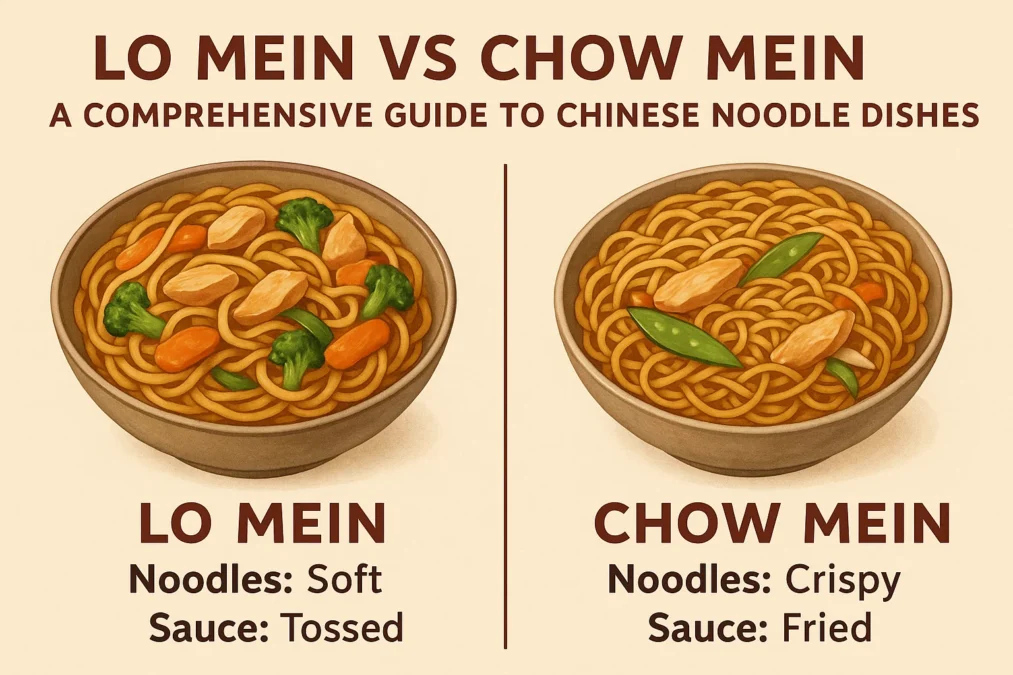Lo Mein vs Chow Mein: When it comes to Chinese cuisine, noodle dishes like lo mein and chow mein are staples that have won the hearts of food lovers worldwide. While they may seem similar at first glance, these two dishes have distinct characteristics that set them apart. From the preparation methods to the texture and flavor profiles, lo mein and chow mein offer unique culinary experiences. In this article, we’ll dive deep into the differences between lo mein and chow mein, explore their ingredients, and even provide tips on how to make them at home. Whether you’re a fan of saucy, soft noodles or crispy, fried ones, this guide will help you understand and appreciate these beloved dishes.
What is Lo Mein?
Lo mein, which translates to “tossed noodles,” is a classic Chinese dish that features soft, chewy noodles mixed with a variety of vegetables, proteins, and a rich, flavorful sauce. The dish is known for its saucy texture and the way the noodles absorb the flavors of the sauce, making every bite a burst of deliciousness.
The Noodles
Lo mein is typically made with fresh egg noodles, which are wheat-based noodles enriched with eggs. These noodles are boiled until they reach an al dente texture—soft yet firm to the bite. The thickness of the noodles allows them to hold up well when tossed with the sauce and other ingredients. If fresh egg noodles aren’t available, you can substitute them with other long noodles like linguine or spaghetti.
The Ingredients
Lo mein is a versatile dish that can include a wide range of ingredients. Common additions include:
- Vegetables: Broccoli, bell peppers, carrots, mushrooms, and snow peas.
- Proteins: Chicken, beef, shrimp, pork, or tofu.
- Sauce: A savory blend of soy sauce, oyster sauce, sesame oil, garlic, and ginger.
The sauce is the star of lo mein, coating the noodles and ingredients generously to create a harmonious blend of flavors.
What is Chow Mein?
Chow mein, meaning “fried noodles,” is another popular Chinese dish that emphasizes the texture of the noodles. Unlike lo mein, chow mein noodles are stir-fried to achieve a crispy or slightly chewy texture, depending on the preparation method.
The Noodles
Chow mein can be made with either fresh or dried egg noodles. The noodles are parboiled and then stir-fried in a hot wok with oil, which gives them their signature crispy texture. In some variations, the noodles are pressed flat and fried to create a crunchy “noodle pancake,” which is then topped with stir-fried vegetables and protein.
The Ingredients
Chow mein is a simpler dish compared to lo mein, with fewer ingredients to let the noodles shine. Common components include:
- Vegetables: Bean sprouts, cabbage, and carrots.
- Proteins: Chicken, shrimp, or tofu.
- Sauce: A light sauce made with soy sauce, oyster sauce, and a touch of sugar.
The sauce in chow mein is used sparingly to avoid making the noodles soggy, allowing their crispy texture to take center stage.
Butter Chicken vs Tikka Masala: The Ultimate Guide to Two Iconic Dishes
Lo Mein vs Chow Mein: Key Differences
While both dishes feature egg noodles, the way they are prepared and served sets them apart. Here’s a breakdown of the main differences:
1. Cooking Method
- Lo Mein: The noodles are boiled and then tossed with pre-cooked ingredients and sauce. The focus is on mixing everything together to create a saucy, cohesive dish.
- Chow Mein: The noodles are parboiled and then stir-fried in a hot wok with oil. The stir-frying process gives the noodles their crispy texture.
2. Texture
- Lo Mein: Soft, chewy, and saucy. The noodles absorb the sauce, making them flavorful and moist.
- Chow Mein: Crispy or slightly chewy, depending on the frying time. The noodles retain their firmness and are less saucy.
3. Sauce
- Lo Mein: Generously coated with a rich, flavorful sauce that binds the dish together.
- Chow Mein: Lightly sauced to preserve the crispy texture of the noodles.
4. Ingredients
- Lo Mein: Includes a variety of vegetables and proteins, making it a more ingredient-heavy dish.
- Chow Mein: Focuses on the noodles, with fewer additional ingredients.
How to Make Lo Mein at Home
Making lo mein at home is easier than you might think. Here’s a step-by-step guide to creating this delicious dish:
Ingredients
- Fresh egg noodles (or substitute with linguine or spaghetti)
- Vegetables (broccoli, bell peppers, carrots, etc.)
- Protein (chicken, shrimp, beef, or tofu)
- Sauce ingredients: soy sauce, oyster sauce, sesame oil, garlic, ginger, and sugar
Instructions
- Boil the Noodles: Cook the noodles according to the package instructions until they are al dente. Drain and set aside.
- Prepare the Sauce: In a small bowl, whisk together the soy sauce, oyster sauce, sesame oil, minced garlic, grated ginger, and a pinch of sugar.
- Cook the Protein and Vegetables: Heat a wok or large skillet over high heat. Add a bit of oil and stir-fry your protein until cooked through. Remove and set aside. In the same wok, stir-fry the vegetables until they are tender-crisp.
- Combine Everything: Add the cooked noodles and protein back to the wok. Pour the sauce over the top and toss everything together until well-coated and heated through.
- Serve: Garnish with chopped green onions or sesame seeds and serve immediately.
How to Make Chow Mein at Home
If you prefer crispy noodles, chow mein is the dish for you. Here’s how to make it:
Ingredients
- Fresh or dried egg noodles
- Vegetables (bean sprouts, cabbage, carrots)
- Protein (chicken, shrimp, or tofu)
- Sauce ingredients: soy sauce, oyster sauce, and a touch of sugar
Instructions
- Parboil the Noodles: Cook the noodles until they are just tender. Drain and set aside.
- Prepare the Sauce: Mix the soy sauce, oyster sauce, and sugar in a small bowl.
- Stir-Fry the Ingredients: Heat a wok or large skillet over high heat. Add oil and stir-fry the protein until cooked. Remove and set aside. In the same wok, stir-fry the vegetables until tender-crisp.
- Fry the Noodles: Add more oil to the wok and stir-fry the noodles until they are crispy.
- Combine Everything: Add the protein and vegetables back to the wok. Pour the sauce over the top and toss everything together.
- Serve: Plate the chow mein and enjoy the crispy, flavorful noodles.
Lo Mein vs. Chow Mein vs. Chop Suey
While lo mein and chow mein are both noodle dishes, chop suey is a different beast altogether. Chop suey is a stir-fried dish that typically includes meat, vegetables, and a thick sauce, but it doesn’t always include noodles. Instead, it’s often served over rice. The key difference is that chop suey is more about the stir-fried ingredients, while lo mein and chow mein focus on the noodles.
FAQs
1. What’s the difference between chicken lo mein and chow mein?
Chicken lo mein features soft, saucy noodles tossed with chicken and vegetables, while chicken chow mein has crispy stir-fried noodles with a lighter sauce.
2. Can I use the same noodles for lo mein and chow mein?
Yes, both dishes use egg noodles. However, lo mein typically uses fresh noodles, while chow mein can use either fresh or dried noodles.
3. Which is healthier, lo mein or chow mein?
Lo mein tends to be saucier and may have more vegetables, making it slightly healthier. However, the healthiness depends on the ingredients and portion sizes.
4. Can I make lo mein or chow mein vegetarian?
Absolutely! Simply omit the meat and use tofu or extra vegetables as your protein source.
5. What’s the best sauce for lo mein?
A combination of soy sauce, oyster sauce, sesame oil, garlic, and ginger creates a flavorful lo mein sauce.
Conclusion
Lo mein and chow mein are both delicious Chinese noodle dishes, but they cater to different tastes and preferences. Lo mein is saucy, soft, and packed with ingredients, while chow mein is crispy, light, and focuses on the noodles. Whether you’re craving something saucy or something crunchy, both dishes are easy to make at home and can be customized to suit your taste. So, the next time you’re in the mood for Chinese food, why not try making your own lo mein or chow mein?
Enjoy your culinary adventure with these iconic Chinese noodle dishes!



